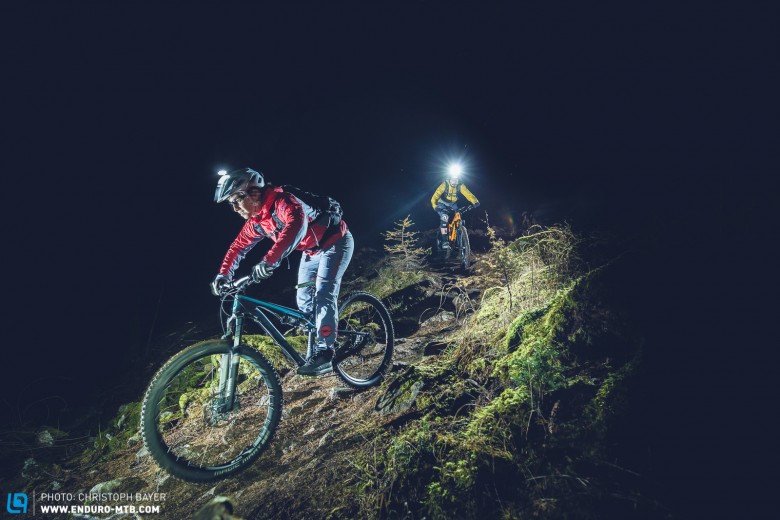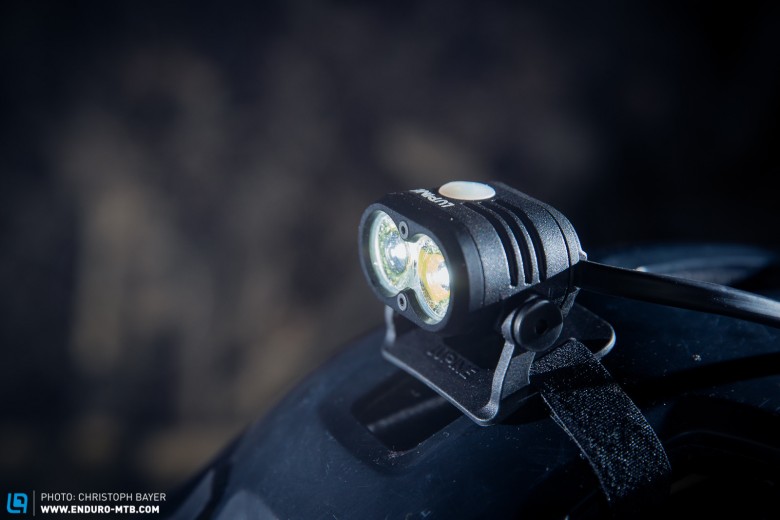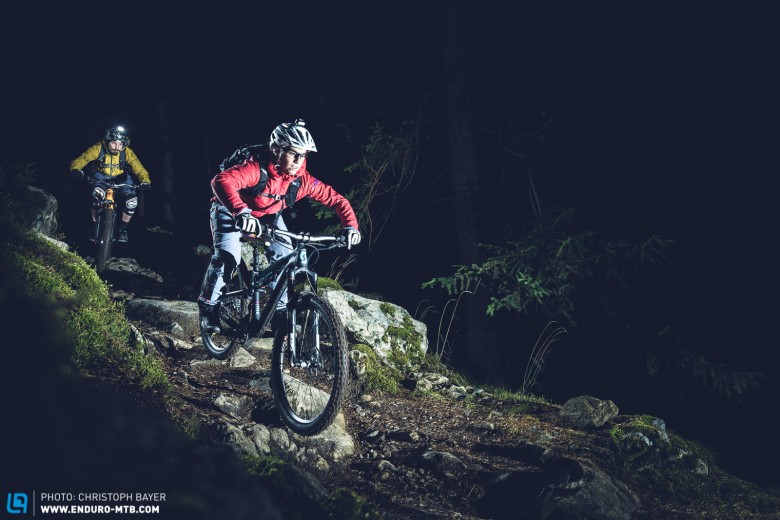Review: Three top Helmet Lights in Comparison

The clocks have been changed and we are now leaving the office to be greeted by darkness as the tungsten glow of streetlights is rapidly left in our wake as we head into the woods. It’s, therefore, high time to stash some decent, trail-worthy lights in your backpack each morning so that you can rely on them for a post-work loop. Having tested three of the market’s current top illuminators, we can now share our thoughts on which ones are best suited to which type of rider.

A good helmet light turns night into day.
All three lights boast around 1,500 lumen, so they’re equally as adept at illuminating pretty much any trail into its deepest corners. Depending on the manufacturer, you can purchase various options for mounts at an extra cost (and sometimes they’re even included). We’ve focused on helmet mounts, as they have proven the most useful if you’re just opting for one light on the trails. This is where the models only have marginal differences, as each light is essentially fixed onto the helmet with a base plate and strap with Velcro. The battery is stashed in your backpack and can be attached to the light with an extension cable. All three candidates faced this set-up as we took them out on nightly excursions along some of South Tirol’s toughest trails as well as back at home on our familiar home trails.
Lupine Piko R 4 SC

Lupine Piko R 4 SC: Lupine sent us the newest version of their popular Piko.
When you consider aspects such as usage and comfort, the Lupine Piko R 4 SC is unlikely to give rise to complaint. Thanks to its low weight and small size, you barely notice its presence on the helmet. Its wireless Bluetooth-compatibility means you can control it from your bars as well as the special app that dictates its settings and control – these are currently unrivalled on the market. The lightweight battery, whose status LEDs can also handily be used as a backlight, does (in a direct comparison) offer the least capacity. However, Lupine do have a further larger model (the R 7), which still manages to be lighter than any of the competing batteries in this test, and offers the longest light duration of 3:30 hours – although this performance naturally comes at a cost.
As the Piko has a wider light beam compared to its peers, it is better suited for more technical trails when you’re riding at a slower pace and need more of an overview. However, the 1,500 lumen are still strong enough for virtually any high-speed trail. The Piko is intuitive to work and the two pre-programmed light levels are well chosen. Using the free smartphone app, you can easily alter and expand these light levels without stressing out over which buttons to press. Thanks to the mass of accessories that are available, the Piko is not limited exclusively to riding, as its low weight and compact form make it a strong contender for running, ski-touring and climbing.
Don’t let the high price put you off; it is justified when you consider the high-quality production and the fact that every single part works, and works damn well too.
Power: 1,500 lm
Price: 350 €
Light duration (max. power): 1:45 h
Weight: Light with mount/switch 82 g, battery with extension cable 197 g, total: 279 g
More info at lupine.de
+ the lightest
+ incredibly well manufactured
+ the most comfortable (Bluetooth compatible, App, combinations available, spacious storing pouch)
– expensive when compared to similar battery lifespans
Lumicycle Summit (Enduro Pack with Helmet Kit)

The Lumicycle Summit sets itself apart from the competition with its larger lamp head.
The first impression of the Lumicycle Summit is its size and stability, although these naturally have a knock-on effect on its weight; it weighs almost double the Lupine Pike. Once mounted, the light has a noticeably high position on the helmet but it stays securely in place without any hint of motion. The Lumicycle works like a regular headlight, adjusted with a two-way rocker switch while the status LED reveals remaining battery life and current light mode. It isn’t the most intuitive of the bunch, and it might take a while for you to get to grips with the settings. One of Lumicycle’s USPs is its gradual dimming as you switch down between the light levels; a feat that should enable the eyes to adapt better to the differences. In theory, it’s a great idea but it did prove a little confusing and prompted us to frequently wonder whether we’d actually pressed the button hard enough to switch it off or not.
Lined up next to the other lights in this group test, this one is the most expensive, but it does deliver the highest light performance and the longest battery life. As its beam of light is quite concentrated, it, therefore, covers the furthest distance, which makes it great for those super quick trails that need you to keep scanning the horizon. If you’d prefer more visibility, then you can combine the Lumicycle with a second headlight for a master/slave mode set-up, in which both can be controlled from one switch.
Power: 1,650 lm
Price: 265 £ (ca. 360 €)
Light duration (max. power): 3:00 h
Weight: Light with mount 149 g, battery with extension cable 318 g, total 467 g
More info at lumicycle.com
+ very bright
+ long battery life
+ can be combined with multiple headlights
– high, heavy attachment
– battery doesn’t directly show current state
Gloworm X2

The Gloworm X2 is the cheapest lamp in this test – can it still deliver?
While weightier than the Lupine, the Gloworm X2 has successfully coined its compact design. Further bonus points can be dished out in the Gloworm X2’s direction too, as it comes with a GoPro Interface on the helmet mount for no additional cost – in fact, its total cost is far lower than its competitors. The X2 is served purely by an external button, which is fixed to the light via a cable and easily fixed onto your helmet with a Velcro fastener. However, this is permanently installed and can be neither lengthened, shortened nor swapped. As a rule, this sort of set-up makes sense for handlebar lights, but there’s no real advantage for a helmet light – especially not when the clever warning function (a double short tap lets it pulse for a second in each of the settings) is rendered a bit useless. The button itself has a spongy feel and requires a very long push to switch it off.
Compared to the other two lights, the Gloworm X2’s beam performance is smack in the middle of its competitors. Its beam is narrower than the Lupine, but it does allow you to see further – although not as far as the Lumicycle. With a battery life of 2 h, it is once again firmly taking the middle ground of the three models. For its price, it’s a solid all-rounder, but cannot compete with the Lupine’s simple usage and manufacturing quality, and nor can it touch on the Lumicycle’s battery life.
Power: 1,500 lm
Price: 180 £ (ca. 245 €)
Light duration (max. power): 2:30 h
Weight: Light with mount/switch 111 g, battery with extension cable 283 g, total 394 g
More info at glowormlites.co.nz
+ good value for money
+ small, fairly light
+ GoPro interface for the mount comes as standard
– operating comfort
– comparably low battery life

All three helmet lights are suited for hitting the trails at night.
Conclusion & Best of Test
Looking at such eyewateringly expensive headlights you have to consider manufacturing quality and long-term value of such a purchase. And this is where the Lupine will not disappoint, as it lights the way to victory in our group test. Not only is it the most intuitive to use, but it’s also the lightest, has the most efficient battery utilization, and an unmatched ability to be used in multiple occasions and many sports. More budget-conscious riders who don’t want to skimp on performance should take a look at the Gloworn X2. The Lumicycle Summit certainly offers the most power and longest battery life, but its heavy weight, less than attractive price and more suitability as a handlebar light put it out of the running for victory as the guiding light for winter riding. The new Hope R4+ would have been another great option in this test, but, unfortunately, didn’t reach our office in time. Make sure to check out the First Look of the Hope Vision R4+.
Text: Andreas Maschke Photo: Christoph Bayer
Did you enjoy this article? If so, we would be stoked if you decide to support us with a monthly contribution. By becoming a supporter of ENDURO, you will help secure a sustainable future for high-quality mountain bike journalism. Click here to learn more.








